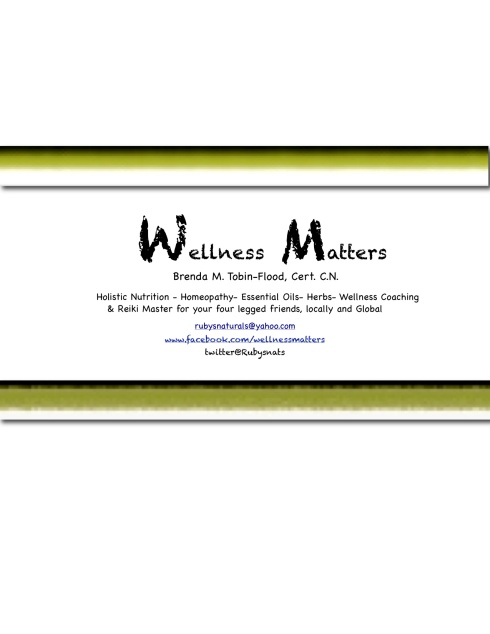When I do a wellness consult for a client the first question I ask is, “ What do you feed your pet right now?” followed by, “Do you read the labels on your pet’s food and/or treat packages? “ If you are feeding your pet packaged food from the store, be sure to read the list of ingredients. While pet food packages are usually covered with colorful, cheery wellness-oriented marketing, the small-print ingredient list can reveal items that you may not want your pet to be eating.
AAFCO (Association of American Feed Control Officials) is the group the pet industry created to use feeding trials which evaluate the nutritional satisfactoriness of pet foods. Initially one would think that AAFCO were protecting our animal feed, however, when taking a closer look, their “Ingredient Definitions” describe meat meal as the rendered product from mammal tissue exclusive of blood, hair, hoof, hide, trimmings, manure, stomach, and rumen contents except in such amounts as may occur unavoidably in good processing practices.” 
Did you know that at rendering plants they use slaughterhouse material, restaurant and supermarket leftovers, dead stock (yes, you read that right) road kill and euthanized companion animals? 4-D animals are picked up and sent to rendering facilities as well. 4-D stands for dead, dying, diseased or down. Pet Food Industry magazine states that a pet food manufacturer might reject rendered material for various reasons, including the presence of foreign material (metals from collars, hair, plastic, rubber and glass), off odor, excessive feathers, hair or hog bristles, bone chunks, mold, chemical analysis out of specification, added blood, leather or calcium carbonate, heavy metals, pesticide contamination, improper grind or bulk density and insect infestation. I don’t know about you, but that all sounds like it should be rejected, not MIGHT be rejected.
Here are some AAFCO definitions that are found on some pet food labels that you may be familiar with:
Meat: The clean flesh derived from slaughtered mammals and is limited to that part of the striate muscle that is skeletal or that which is found in the tongue, diaphragm, heart, or esophagus; with or without the accompanying and overlying fat and the portions of the skin, sinew, nerve, and blood vessels that normally accompany the flesh.
When I think of Meat added as an ingredient I am picturing a steak, chicken, or lamb that we may be accustomed to eating. Not the scrap parts as described above. Although heart and tongue are, in my opinion, excellent sources of meat when feeding a raw diet.
Meat by-products: This is the non-rendered, clean parts other than meat derived from slaughtered mammals. It includes, but is not limited to, lungs, spleen, kidneys, brain, livers, blood, bone, partially defatted low temperature fatty tissue, and the stomachs and intestines freed of their contents. **Please note that these are not fit for human consumption. The livers can contain worms and if the lungs contain pneumonia they are “fit” to be used for pet food.
Poultry by-product: Include non rendered clean parts of carcasses of slaughtered poultry such as heads, feet, and viscera. All this content is supposed to be free of fecal content and foreign matter except those that are found in trace amounts.
Meat, meat by-product and poultry by-product meal: The term meal means that the product is not fresh, it is rendered down, heated up and made into a fine powder like substance. Legally, 4-D remains can make up meat and poultry meal.
AAFCO has a long list of corn products that can be used in pet foods; Corn Gluten Meal, Corn flour and Corn bran. They also have a lengthy list of Wheat products and give descriptive terms such as Wheat Flour which is mixed together with fine particles of wheat bran, wheat germ and the offal from the “tail of the mill.” The Tail of the mill is the sweepings or the leftovers after everything has been processed for the week.
Corn and wheat are cheap fillers that are put in dog and cat foods. Cat’s are obligatory carnivores, why are they receiving grains in their food source?
Fats are sprayed heavily on cheap processed pet foods because they are primarily made out of inexpensive grain and by-products. The fats make the food more palatable for your dog or cat. This is why when switching your pet from an inexpensive food over to a species appropriate diet such as the raw diet, or a holistic and/or organic food, they may refuse the new food. It is like if you eat fast food for every meal and then I offered you a salad. It most likely wouldn’t be that tasty to you at first.
Sugars and salts are also added to commercial pet food as are harmful dyes, additives and preservatives. Do you really think your pet cares what their food looks like?
Read the label for your pet’s food and treats. Chances are if you cannot make sense of the label and recognize the ingredients as real food then it is not a healthy choice for your pet. Their nutrition and health matter too. Your pet will experience less nutritional allergies, such as licking their feet and chronic ear infections and with better food choices they will be healthier and happier.
Confused about your pet’s diet? I can help with a Wellness Consult. Kindly contact me at rubysnaturals@yahoo.com for more information.
Written by: Brenda M. Tobin-Flood, Cert. C.N.
To request a Wellness Consult for your pet kindly contact me at rubysnaturals@yahoo.com



